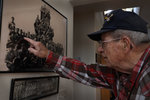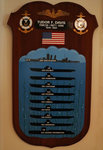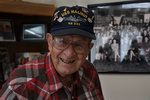


At 95, Tudor Davis of Battle Ground has experienced The Great Depression, the invention of television and, most vividly, World War II. He is the last known surviving member of the U.S.S. Halibut.
Tudor was born on May 16, 1924, in the coal town of Pottsville, Pennsylvania. His father, Tudor Davis Sr., was a coal miner and his mother, Louis Davis, a homemaker.
“We were poor. There was things I’ve never thought of eating before like avocados,” Tudor remembers. “We never had big steaks. We had roasts and hams and liver but not often, they were a treasure. I never made a pig of myself.”
Tudor carried that mentality to the Navy.
“I was raised in the era where mom said ‘take all you want but eat all you take’ and when I went into the Navy there was signs in the mess hall that ironically said ‘take all you want but eat all you take.’ I never turned down a meal.”
Tudor enlisted in the Navy in 1941 at 17 years old and was called to action following the attack on Pearl Harbor on December 7, 1941. He spent the next 20 years serving on submarines until his retirement as a Chief Petty Officer in 1961.
During his service, Tudor spent time on 10 different ships, starting with a New Orleans Class Cruiser, the U.S.S. Tuscaloosa where he spent time in and around the Arctic Ocean.
Tudor recalled a vivid memory while serving on the U.S.S. Tuscaloosa in the summer of 1942 during what was code-named “Convoy PQ-17” which departed from Hvalfjord, Iceland on June 27, 1942.
“July third, fourth and fifth of 1942 we had 30-some surface ships in our protection. There were four cruisers, two were British and two were U.S. Navy,” Tudor said.
Tudor’s convoy was escorting about 20 destroyers to the Soviet Union, but never got there.
“We got up in the Baltic Sea and the German Luftwaffe (airplanes) and the German submarines simultaneously started sinking the ships we were escorting. We lost over 70% of them. That was our second trip there.”
In this attack, Convoy PQ-17 lost 24 of the 35 merchant ships it was escorting resulting in the death of 153 merchant mariners.
Following this, in August of 1942 Tudor received a letter from his cousin who was serving in the Navy on submarines. The letter told him to get off the surface craft.
“‘you better get off that surface craft, you’ll never get a rate all the time you’re in the war,’” Tudor recalls the letter saying. “‘Come into submarines where you’ll be respected for what you learn.’”
Tudor took his advice.
Starting with service on the U.S.S. Halibut, Tudor served on nine different submarines up to the U.S.S. George Washington, the first of what he describes as “modern submarines.” The U.S.S. George Washington was the United States first operational ballistic missile submarine.
Tudor most vividly recalls his time spent on the U.S.S. Halibut, a Gato-class submarine which was the first ship of the United States Navy to be named for the halibut fish.
The Halibut spent most of its time patrolling the Pacific Ocean near Japan and sunk a total of 26 Japanese ships — seven of them being warships.
“On that boat, I made six patrols,” Tudor said about the Halibut. “It made 10 totally. The last one was when we got ‘beat up,’ that was our last patrol.”
On the night of November 13, 1944, the Halibut was nearly destroyed on its tenth patrol.
“We got depth charged so bad, we had to operate everything by hand,” Tudor remembers. “We couldn’t operate anything hydraulically. What used to take us 17 to 20 seconds to dive, now took us 20 minutes to dive.”
The attack happened after Tudor’s submarine entered the Bashi Channel and launched four torpedoes. As the Halibut submerged and began to retreat, five explosions from “jiktanchiki-equipped Mitsubishi G3M aircraft” hit the submarine and it fell 325 feet. After a few more explosions, The Halibut fell a total of 420 feet. After a time the sub was able to regain its footing at 300 feet and radio in. At around 9:30 p.m. that night, the sub encountered the U.S.S. Pintado, its escort back home.
“That depth charge attack… I’ll never forget.”
The Halibut arrived back at Pearl Harbor at the beginning of December 1944 and was decommissioned in Portsmouth, New Hampshire the following year.
Despite this, Tudor chose to stay in the navy for another 18 years working and serving on submarines.
“You might laugh at this but I stayed in the Navy because I didn’t want to go home,” Tudor said. “I hated civilians.”
Tudor later said it was the attitude of civilians that kept him in the Navy. Stating that they were ‘always crying’ and treated you great when you came home but only for a few days.
Tudor served in the Navy until 1961 when he retired as a Chief Petty Officer. Prior to what Tudor describes as “getting beat up” he received his dolphins in October of 1943.
“This is a significant pin, referred to as ‘The Dolphins,’” Tudor’s son, Fred Davis, explained. “Once a submarine sailor gets qualified aboard a submarine, which means he knows everything about all of the systems from stem to stern, then he earns his dolphins.”
After his retirement from the Navy, Tudor moved on to work in field engineering for Lockheed Missiles and Space Company and was even on board during the first successful submerged missile launch on July 20, 1960.
Tudor finally settled down at a farm in the Battle Ground area in the 1970s with Betty, his wife of 30 years, and their three kids: Cathy, Mary and Fred. He continued to keep up with his Navy buddies, though, through a group known as the “Submarine Veterans of World War II” started in 1954.
“We just got together to BS and drink and dance and talk about old times,” Tudor said about the group, explaining later that there was nothing like the people he met in the Navy. The group continued to meet yearly between 1941-61 and semi-regularly after that. Its final convention was in Norfolk, Virginia in 2012.
Davis was also significant in improving the submarine education for those in the Pacific Northwest as he was instrumental in bringing the U.S.S. Blueback to the Oregon Museum of Science and Industry (OMSI). The Blueback, a mainstay for school field trips and nautical lovers alike, was brought to OMSI in February of 1994 after being decommissioned in 1990. The Blueback was the last non-nuclear submarine built by the US Navy in April of 1957.
“We’re the ones that got it here,” Tudor said about Admiral Jack Barrett and the team. “We worked on it when it came here for three or four months to get it ready for visitors.”
And get visitors it does. Since it opened, OMSI has offered guided tours, educational field trips and even sleep-ins on the vessel. The vessel is even a movie star, as it made an appearance in the 1990 movie, “The Hunt for Red October.”
However, Admiral Barrett was more than a helper for the project. To Tudor, he was a longtime friend.
They met when Tudor first started in the Navy and were friends up until Barrett passed in April of 2009. “I knew him longer than I knew my family,” Tudor said.
Tudor recalls many great people and events from his time seeing the world while serving.
“I like every place I’ve ever been,” Tudor said. “When the war ended we met the Japanese people and they were the nicest people in the world. And it was then I think that we all sat down and said ‘hey, it’s not the people of these countries (that are bad) it’s the leaders that are no good.”
Today, Tudor likes to spend his free time mowing yards, picking up weeds and drinking beer - most notably his favorite, Yuengling, the oldest operating brewery in America, which also happens to be from his hometown of Pottsville, Pennsylvania. Along with drinking a beer whose name means “youngling” in German, Tudor said that his key to living a long life was doing everything he wanted to do and working out.
“I worked out constantly, I still work out,” Tudor said. A few of his favorite workout routines include bench pressing and riding his indoor bicycle.
As for advice, Tudor said that if a young man or young woman is lacking direction they should go into the service.
“Put two or four years into the service then decide what you’re going to do,” he said. “If you love what you’re doing in the service, stay. Don’t think about coming out.”
Tudor still lives in Battle Ground on the property that used to be his farm and enjoys visits from his three kids and 11 grandkids. This May he helped “send off” military enlistees from the area as they graduated from high school for the second year in a row.
Tudor said the greatest thing he learned while serving in the Navy was friendship and respect. “Never forget your friends,” he said. “Never forget your friends.”